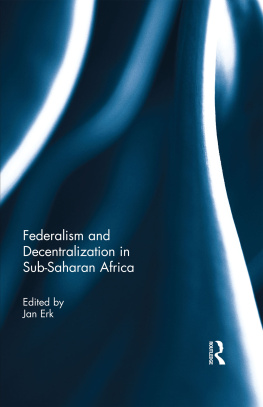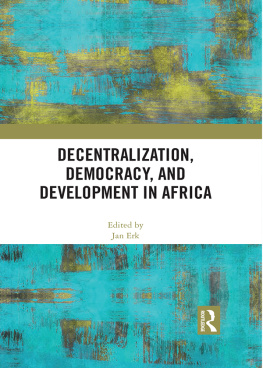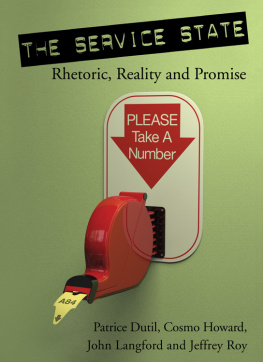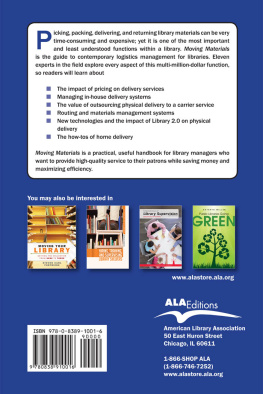WORLD BANK WORKING PAPER NO. 131
Copyright
Copyright 2008
The International Bank for Reconstruction and Development / The World Bank
1818 H Street, N.W.
Washington, D.C. 20433, U.S.A.
All rights reserved
Manufactured in the United States of America
First Printing: January 2008

1 2 3 4 5 11 10 09 08
World Bank Working Papers are published to communicate the results of the Banks work to the development community with the least possible delay. The manuscript of this paper therefore has not been prepared in accordance with the procedures appropriate to formally-edited texts. Some sources cited in this paper may be informal documents that are not readily available.
The findings, interpretations, and conclusions expressed herein are those of the author(s) and do not necessarily reflect the views of the International Bank for Reconstruction and Development/The World Bank and its affiliated organizations, or those of the Executive Directors of The World Bank or the governments they represent.
The World Bank does not guarantee the accuracy of the data included in this work. The boundaries, colors,denominations, and other information shown on any map in this work do not imply any judgment on the part of The World Bank of the legal status of any territory or the endorsement or acceptance of such boundaries.
The material in this publication is copyrighted. Copying and/or transmitting portions or all of this work without permission may be a violation of applicable law. The International Bank for Reconstruction and Development/The World Bank encourages dissemination of its work and will normally grant permission promptly to reproduce portions of the work.
For permission to photocopy or reprint any part of this work, please send a request with complete information to the Copyright Clearance Center, Inc., 222 Rosewood Drive, Danvers, MA 01923, USA, Tel: 978-750-8400, Fax: 978-750-4470, www.copyright.com.
All other queries on rights and licenses, including subsidiary rights, should be addressed to the Office of the Publisher, The World Bank, 1818 H Street NW,Washington, DC 20433, USA, Fax: 202-522-2422, email: .
ISBN-13: 978-0-8213-7382-8
eISBN: 978-0-8213-7383-5
ISSN: 1726-5878 DOI: 10.1596/978-0-8213-7382-8
Marito Garcia is a Lead Economist in the Africa Region Human Development Department of the World Bank. Andrew Sunil Rajkumar is an Economist in the same department.
Library of Congress Cataloging-in-Publication Data has been requested
Contents
Contents
| Foreword |
| Acknowledgments |
| Acronyms and Abbreviations |
| Executive Summary |
| 1. | Improvements in Health and Education Services |
| Changes in Outcomes over the Past 15 Years |
| Was Decentralization Responsible? |
| 2. | Decentralization and the Delivery of Basic Services |
| Phasing in Decentralization |
| A Framework for Understanding Service Delivery Outcomes |
| 3. | The Scope of Decentralization and Intergovernmental Fiscal Transfers |
| Subnational Structures |
| Decentralization of Functions and Responsibilities |
| Financing Social Services through Intergovernmental Transfers |
| 4. | How Did Decentralization to Woreda Level Affect the Delivery of Social Services? |
| Increases in Woreda-Level Spending Following Decentralization |
| Decentralization Appears to Have Improved the Distribution of Expenditures Across Woredas with Worse-off Woredas Benefiting the Most |
| After Woreda-Level Decentralization Began, Some Evidence of Lagging Woredas Partly Catching Up in Social Service Delivery |
| Teacher Redeployment Across Woredas and Within Woredas |
| Regression Analysis: Linking Expenditures with Outcomes |
| Decentralization's High Potential to Improve Service Delivery |
| 5. | Making Decentralization Work: Overcoming Constraints in Decentralized Service Delivery |
| Critical Constraints |
| Regional Innovations for Recruiting and Retaining Workers |
| Empowering Citizens and Communities to Improve Services and Outcomes |
| Improving Accountability Mechanisms |
Appendixes
| A | Calculating Block Grants Allocations From Federal Government to Regions and Regions to Woredas Using the Three-Parameter Formula |
| B | The Fiscal Equalization and Unit Cost Approaches for Block Grant Allocations |
| C | Regression Results on Education Outcomes Before and After Decentralization |
| D | Estimating the Effects of Decentralization on the Delivery of Human Development Services in Ethiopia |
| E | Methodology and Technical Details for Data Analysis in |
| References |
List of Tables
| 1.1. | Index of Real Government Expenditures and Spending as Percentage of GDP, 19992005 |
| 1.2. | User Satisfaction with Government Health Services, 2005 |
| 1.3. | User Satisfaction with School Services, 2005 |
| 2.1. | Trends in Service Delivery, 1995/962004/05 |
| 3.1. | Assignment of Expenditure and Revenue Responsibilities for Education, Health, and Water and Sanitation, by Tier of Government, circa 2005 |
| 3.2. | A Wide Variation in Per Capita Block Grant Transfers to Regions |
| 3.3. | Two Different Approaches for Allocating Federal Resources to Regions |
| 3.4. | Regional Budgets and Share of Budgets Transferred to Woredas in Four Regions, 2005/06 |
| 3.5. | Block Grant Allocations in Oromiya, 2002/032004/05 |
| 3.6. | Block Grant Allocations in SNNPR, 2002/032004/05 |
| 3.7. | Trends in Regional Expenditure, 1993/42005/06 |
| 3.8. | Aggregate Fiscal Performance |
| 4.1. | Woreda-Level Spending on Education and Health in SNNPR, by Category of Spending, 2001 and 2004 |
| 4.2. | Woreda-Level Per Capita Spending on Education and Health in Oromiya, by Category of Spending, 2001 and 2004 |
| 4.3. | Woreda-Level Spending on Education and Health in SNNPR, by Type of Woreda, 2001 and 2004 |
| 4.4. | Recurrent Expenditure Per Primary Student in SNNPR, 2001 and 2004 |
| 4.5. | Recurrent Expenditure Per Secondary Student in SNNPR, 2001 and 2004 |
| 4.6. | Education Outcomes in SNNPR, 2001 and 2004 |
| 4.7. | Primary Education Outcomes in Oromiya, 2001 and 2004 |









